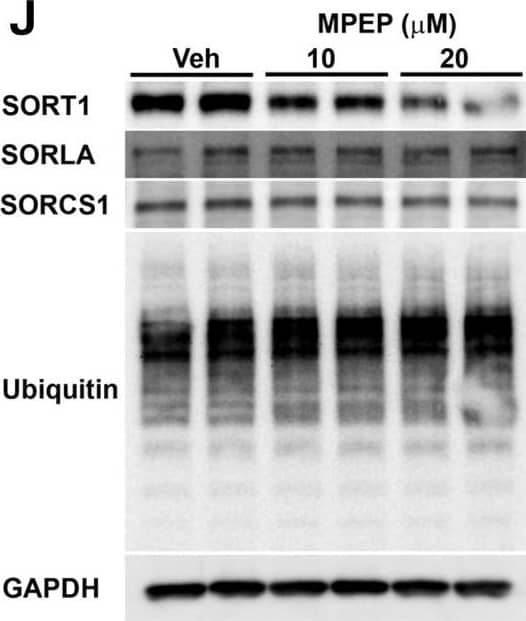Human SorCS1 Antibody
R&D Systems, part of Bio-Techne | Catalog # AF3457

Key Product Details
Species Reactivity
Validated:
Cited:
Applications
Validated:
Cited:
Label
Antibody Source
Product Specifications
Immunogen
Ser111-Ser1099 (Ser231Gly)
Accession # Q8WY21.3
Specificity
Clonality
Host
Isotype
Scientific Data Images for Human SorCS1 Antibody
Detection of SorCS1 by Western Blot
MPEP decreases SORT1 expression and increases extracellular PGRN in mammalian cell lines. (A and B) M17 cells were treated with control siRNA (siR-Ctrl) or gene-specific SORT1 siRNA (siR-SORT1). (A) Intracellular levels of PGRN, SORT1 and GAPDH were evaluated by western blot at a 48 h time-point. (B) Suppression of SORT1 levels increased extracellular PGRN levels. (C) Chemical name and structure of MPEP. (D–I) Treatment of M17 cells (D and E), HeLa cells (F and G) or NIH3T3 cells (H and I) with MPEP for 24 h dose dependently reduced SORT1 levels (D, F and H) and increased exPGRN levels (E, G and I) at 10 and 20 μM. (J) Under the same conditions, MPEP did not affect levels of SORLA, SORCS1 and ubiquitinated proteins in M17 cells. ***P < 0.001 versus vehicle control, analysis performed by one-way ANOVA followed by Tukey's post-test. Image collected and cropped by CiteAb from the following open publication (https://pubmed.ncbi.nlm.nih.gov/24163244), licensed under a CC-BY license. Not internally tested by R&D Systems.Applications for Human SorCS1 Antibody
Immunocytochemistry
Sample: Immersion fixed beta TC-6 mouse beta cell insulinoma cell line
Western Blot
Sample: Recombinant Human SorCS1 (Catalog # 3457-SR)
Reviewed Applications
Read 3 reviews rated 5 using AF3457 in the following applications:
Formulation, Preparation, and Storage
Purification
Reconstitution
Formulation
Shipping
Stability & Storage
- 12 months from date of receipt, -20 to -70 °C as supplied.
- 1 month, 2 to 8 °C under sterile conditions after reconstitution.
- 6 months, -20 to -70 °C under sterile conditions after reconstitution.
Background: SorCS1
SorCS1 is a type I transmembrane receptor of the mammalian Vps10p (vacuolar protein-sorting 10 protein) family (1, 2). These sorting receptors include sortilin, SorLA, and three SorCS proteins. Three splicing variants (SorCS1a, b and c) differ only in their cytoplasmic domains (3). All variants are predominantly expressed in the central nervous system, but SorCS1 can also be identified in heart, kidney and pancreatic islets (2‑5). SorCS1a mediates endocytosis, and only ~10% of it is expressed on the cell surface. SorCS1b shows higher surface expression (~45%) and is much less involved in endocytosis. SorCS1c is intermediate. Human SorCS1a is synthesized as a 1159 amino acid (aa) preproform with a 33 aa signal sequence and a 77 aa propeptide. After proteolytic processing at a furin-type consensus sequence, the mature SorCS1a is a 1049 aa, 130 kDa protein with a 989 aa extracellular/lumenal domain (ECD). Within the ECD, human SorCS1 shares 93%, 94%, 93% and 98% aa identity with mouse, rat, bovine and canine SorCS1, respectively. It also shares 70% and 46% aa identity with the ECD of human SorCS3 and SorCS2, respectively. The ECD contains an imperfect leucine-rich repeat (LRR) and a Vps10p domain and binds the growth factor PDGF-BB (1, 2, 6). Expression in the hippocampus indicates that SorCS1 may modulate PDGF-BB activity in this location (6). SorCS1 has also been identified as a susceptibility gene for type 2 diabetes in overweight females (4). Consequently, it has been proposed to affect insulin secretion by modifying PDGF-mediated growth of the islet vasculature (7). The 80 kDa ECD may be constitutively or inducibly shed, mainly via the metalloproteinase TACE/ADAM17 (6). The shed soluble form also binds PDGF. The cellular portion appears to undergo regulated intramembrane proteolysis (8).
References
- Hampe, W. et al. (2001) Hum. Genet. 108:529.
- Hermey, G. et al. (1999) Biochem. Biophys. Res. Commun. 266:347.
- Hermey, G. et al. (2003) J. Biol. Chem. 278:7390.
- Clee, S.M. et al. (2006) Nat. Genet. 38:688.
- Hermey, G. et al. (2001) Neurosci. Lett. 313:83.
- Hermey, G. et al. (2006) Biochem. J. 395:285.
- Goodarzi, M.O. et al. (2007) Diabetes Apr 10 [Epub ahead of print].
- Nyborg, A.C. et al. (2006) Mol. Neurodegen. 1:3.
Long Name
Alternate Names
Gene Symbol
UniProt
Additional SorCS1 Products
Product Documents for Human SorCS1 Antibody
Product Specific Notices for Human SorCS1 Antibody
For research use only
